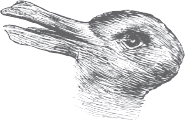
The activity of seeking and/or conveying meaning, especially the meaning of an object understood to carry, reveal, or secrete something worth attending to. Interpretation requires the hypothesis that meaning lies above, below, behind, or within the object (the choice of metaphor will be a consistent and revealing theme), by virtue of which the attention lavished upon it may be justified, or at least explained. As a heuristic, one may adopt the distinction between interpretation and description, the latter of which purports not to convey the meaning of an object but rather to reproduce its features. In the HUMANITIES, descriptive work tends to concentrate on form (e.g., lyric, film), technique (e.g., meter, montage), and style (e.g., Sapphic, Neorealist)—in sum, what one might call “effects.” Interpretation, by contrast, tends toward social, political, and psychological “causes.” The binary has considerably less purchase within the modern sciences, though why this should be the case remains opaque, particularly when one considers that the distinction was well marked in the history of science (e.g., natural history vs. natural philosophy). Polemicists in the academy have made interpretation into a wedge between arbitrary and disreputable factions: on one hand, proponents of “depth interpretation,” who define their project as the discovery of latent meaning; on the other hand, proponents of “surface interpretation,” who dismiss latent meaning as a neurotic projection of the interpreter him/herself, and define their own project as a return to meaning that is manifest. To the sociologist, the issue may be the narcissism of minor difference: the parties, it could be argued, commonly exaggerate their “ideological” conflicts precisely in order to conceal the remarkable similarity of their labor (writing commentary on canonical texts with a vocabulary casually borrowed from French and German philosophers). One must acknowledge that both schools of interpretation trade on a shared metaphor, namely, that the text and its meaning form a three-dimensional object that exists in Euclidean space; and furthermore, that scholarly work has to do with the proper positioning of oneself at one (or more?) points relative to that object, and hence standing “in relation to” the text-interpretation manifold. All of this betrays the extraordinary difficulty of understanding interpretation in a way that does not presume what interpretation is. Attempts to do so inevitably embarrass the people involved. What is worse, such efforts distract from the urgent task of defending interpretation itself. A hasty review would disclose the enormous variety of interpretive techniques that have influenced western culture—e.g., philology, hermeneutics (Talmudic, Biblical, philosophical, objective, etc.), Marxism, psychoanalysis—and also the ease with which any of them may be said to anticipate (and therefore belong to?) the schools of interpretation that are momentarily fashionable. But none of this can explain why one might interpret an object today. As efforts to outsource interpretation (to machines, to “crowd sourcing”) continue, the debate about various kinds of interpretation may eventually appear a quaint reminder of a time when interpretation mattered at all.
